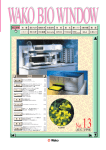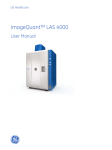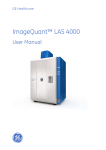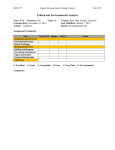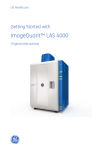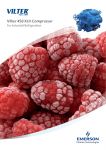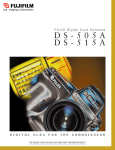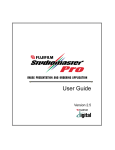Download Fujifilm LAS-3OOO User's Manual
Transcript
Specifications and Applications Image Capturing Unit (Camera Head and Controller) CCD chip Number of pixels Pixel size Fujifilm Super CCD Area Type chip 3.2M pixels 10.75 x 10.75µm Cooling Two-stage thermoelectric module with air circulation Cooling temperature -30°C (when room is below 28°C) Focusing Power focusing; remote and preset control Exposure time 1/100 second to 30 hrs (2 hrs to 30 hrs to be set manually) Dynamic range Four orders of magnitude Gradation 16 bits (65,536) Image size 12.6MB Max.; 49.2KB Min. Maximum sample size 25 x 25cm (wide angle lens); 14 x 21cm (Fujinon VRF43LMD lens) Binning 1 x 2, 2 x 4, 4 x 8, and 8 x 16 pixels Interface USB1.1 Software Fujifilm Image Reader (Mac and Windows ) Image analysis Fujifilm Image Gauge (Mac™); Fujifilm MultiGauge (Windows®) ® Dimensions and Weights Camera head 180 (W) x 170 (H) x 250mm (D) 3.4kg Dark Box IV 510 (W) x 730 (H) x 480mm (D) 49.0kg Chemiluminescence Set a tray Windows® XP or Mac™ OS 9 & X Applicable Reagents and/or Samples Chemiluminescence CDP-Star®, ECL™, ECL Plus™, SuperSignal, ImmunoStar, CSPD® Fluorescence EtBr (W/UV light), SYBR® Green I & II, SYPRO® Orange, GFP, DY-458XL (blue LED) Sample Chemiluminescence Mode Pro-Q™ Diamond, Cy™3, RFP, DY-520XL (green LED), Alexa Fluor 633, Cy™5, DY-647 (red LED) Chemifluorescence *AttoPhos™ Digitization CBB-stained gel, Silver stained gel (Transilluminator) NBT/BCIP-stained membrane. MW marker (Epi-illuminator) Remote controlled focusing EPI-illuminator for fluorescence blue LED (470nm), green LED (520nm), red LED (630nm) EPI-illuminator for digitization White-light source Transilluminator - for digitization of stained gels and autoradiographic films White LED UV transilluminator** UV-light source (312nm) Filter turret Five positions Fluorescence Chemifluorescence UV transilluminator Intelligent Dark Box IV Exposure Filter blue LED green LED red LED Fluorescence Chemifluorescence Mode Digitization White light epi-illuminator White transilluminator Printers Pictrography 3500 Lens Remote Controlled Sample is placed on a tray Analyzing Unit Operating system Super CCD The binning mode of the LAS-3000 allows researchers to select from four binning settings to enhance both imaging sensitivity and image resolution. Image capture ™ Analysis Lens High-sensitivity lens (FUJINON VRF43LMD) Wide-view lens F-number 0.85 F-number Focal length 43mm Focal length 24mm Focus Remote power focusing Focus Manual Mount Bayonet Mount Adapter to Nikon F mount Digitize Mode 2.0 Science Imaging System The image analysis process captures images in three modes: chemiluminescence, fluorescence/chemifluorescence and digitization. Fuji Photo Film Co., Ltd. 26-30, Nishiazabu 2-Chome, Minato-ku, Tokyo 106-8620, Japan, Tel: +81-3-3406-2201, Fax: +81-3-3406-2158 • http://lifescience.fujifilm.com • E-mail: [email protected] Fujifilm Medical Systems U.S.A., Inc. 419 West Avenue, Stamford, CT 06902, U.S.A., Tel: +1-203-324-2000 ext. 6112 (1-800-431-1850 ext. 6112 in the U.S.), Fax: +1-203-351-4713 • http://www.fujimed.com • E-mail: [email protected] Fuji Photo Film (Europe) GmbH, Heesenstr. 31, 40549 Düsseldorf, Germany, Tel: +49-211-5089-174, Fax: +49-211-5089-139 • http://www.fujifilm.de • E-mail: [email protected] Specifications and system configuration subject to change for improvement without notice. All other product names mentioned herein are the trademarks of their respective owners. Ref. No. BB-204E (04,09) *No license is granted for use of AttoPhos™ to detect nucleic acid on a nylon membrane. **No license is granted for pre-labeling gel electrophoresis method with the UV transilluminator. LAS-3OOO Luminescent image analyzer (LAS) for applications requiring high sensitivity and a wide range of fluorescent capabilities GFP expression in tobacco leaf Detection of EPO as doping substance in sports Isoelectric profiles of natural EPO found in normal human urine (B) and the bands found in urine after injections of epoetin or darbepoetin. Data courtesy of Dr. Françoise Lasne. Laboratoire National de Dépistage du Dopage, Châtenay-Malabry, France The LAS-3000 imaging system combines Fujifilm’s high-sensitivity Super CCD camera technology with the added versatility of white, blue, green and red EPI illuminators. The Super CCD imaging chip, binning mode and specially designed camera lens allow researchers to capture faint-light luminescent images with unprecedented sensitivity and resolution. Multicolor illuminator options enlarge application area in fluorescent imaging. More sensitivity for chemiluminescent detection More versatility for fluorescent detection Western blotting, Southern blotting and Northern blotting detection by chemiluminescence is a widely accepted method. The use of a cooled CCD camera system enables the generation of a digital image and quantitative analysis of the image’s signal strength. More and more fluorescent dyes are introduced into the biochemistry and molecular biology fields for staining proteins and nucleic acids in gels, membranes and well plates. Expression analysis using green fluorescent protein (GFP) and red fluorescent protein (RFP) can be detected by blue excitation or green excitation respectively. Several state-of-the-art technologies were incorporated to make the LAS-3000 system as sensitive as the conventional film method: • The newly designed F0.85 high-sensitivity Fujinon lens gathers as much light as possible onto the CCD. • The CCD is a 3.2M-pixel Super CCD having large octagonal-shaped CCD pixels 10.75 x 10.75µm in size. • The CCD is cooled to -30°C by peltier when the environment is below 28°C. • Pixel binning in the LAS-3000 electronically increases the pixel area to increase sensitivity. The binning mode includes four binning levels: 1 x 2 (Standard), 2 x 4 (High), 4 x 8 (Super) and 8 x 16 (Ultra). In the Ultra mode, the exposure time is nearly 60 times faster than Standard. An image smoothing function increases the pixels to make the image size the same as the Standard. • Long exposure times are required to capture images of extremely low-light samples. The low-noise design of the LAS-3000 system includes default settings for a two-hour exposure and a 15-hour exposure in addition to manual settings for exposures as long as 30 hours. Fujifilm Super CCD Area Type imaging chip Users are able to control the LAS-3000 with the Image Reader software in either the user-friendly Lite mode or the more advanced Pro mode. The modes are selected with the click of a mouse. Super CCD - By rotating pixels 45 degrees to form an interwoven layout, the Super CCD’s pixel pitch in the horizontal and vertical directions is narrower than in the diagonal direction, achieving higher horizontal and vertical resolution. The five-position filter turret holds 77mm filters, such as Y515 (general purpose for blue LED excitation), 510DF10 (GFP, etc.), 575DF20 (RFP, Cy™3, Pro-Q™Diamond, etc.), R670 (Cy™5, ALEXA Fluor® 633, etc.) and 605DF40 (EtBr, etc.). Quantitative image analysis function The 16-bit signal accumulated on each CCD pixel is processed through an A/D converter to form a digital image. The image data obtained at the closed shutter condition is the dark frame. The image data of an even, flat sample is the flat frame. To analyze the image data, the dark frame and flat frame data are subtracted from the original image. This correction function is included in the Image Reader software. MultiGauge software for Windows® and ImageGauge software for Mac™ are the standard image analysis software included in the ScienceLab software provided by Fujifilm. Digitizing functions Capturing images as we see them is called digitizing. For CBB-stained gel or silverstained gel, use of the white LED DIAilluminator at iris f2.8 without any filter is recommended. For digitizing the molecular weight standard on blotted membrane, white light epi-illuminator, which is located in the center part of the blue, green and red LED epi-illuminator unit, is used. FUJINON lens VRF43LMD and five-position filter turret Applications Fluorescence/Chemifluorescence Blue: SYBR® Green I & II SYPRO® Ruby SYPRO® Tangerine FAM™ ECFP DY-458XL SYBR® Gold SYPRO® Orange FITC EGFP AttoPhos™ Green: SYPRO® Red TAMRA™ HEX™ Alexa Fluor® 546 Pro-Q™ Diamond BODIPY®576/589 R-phycoerythrin HNPP DY-547 Cy™3 ROX™ Alexa Fluor® 532 Deep Purple Rhodamine Red™ NED™ RFP DY-520XL Red: Alexa Fluor® 633 Alexa Fluor® 647 BODIPY®650/665 TOTO®-3 DY-647 Alexa Fluor® 635 Cy™5 DiD DDAO phosphate UV: Ethidium Bromide SYPRO® Rose White: Silver stained NBT / BCIP CBB X-ray film Chemiluminecence NP Tray • Samples are placed on the appropriate tray and placed in the intelligent dark box. After closing the door, all the functions are controlled remotely from the Image Reader software. The software automatically recognizes the type of illuminator installed or changed during operation. The LAS-3000 includes multiple LED options for various fluorescence applications, including blue LED (470nm), green LED (520nm) and red LED (630nm) for epi-illumination and a UV (312nm) light source for DIA-illumination. • A non-parallax (NP) tray is used to eliminate the parallax effect when imaging chemiluminescence in the 96-well plate. Up to two plates can be placed. C H E M I L U M I N E S C E N C E Easy-to-use operation The five filter options available for the LAS-3000. F L U O R E S C E N C E / C H E M I F L U O R E S C E N C E • LED units D I G I T I Z A T I O N ECL™ ECL Advance™ Super Signal® CSPD® Bright-Star™ ECL Plus™ Lumi-Light Plus CDP-Star™ Renaissance™


